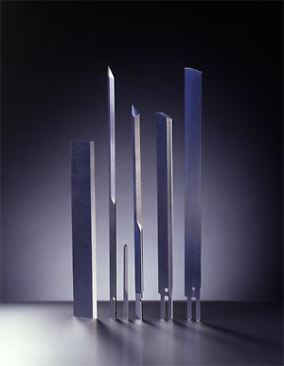When material is to be separated, slotted, granulated or chipped, the tools that can be used are knives. Knives can come in a variety of forms, from flat tools with a very sharp cutting edge, to round tools with several cutting edges. They can be used for a variety of materials and applications including: cutting wood, textiles, paper, plastic, rubber, metals.
Knives applications
Plastic cutting often involves pelletizer knives and granulating knives, needing very high abrasive wear resistance as the plastic polymers or plastic waste cut often contain hard fibres that otherwise quickly can deteriorate a less wear resistant material. Good thermal properties are important for cutting plastic, but even more important when cutting paper and wood.
When cutting paper and wood the use of cooling media is rather restricted, this puts an emphasis on high temperature properties. For cutting paper, tools include sheeter cutters, slitter knives and rotary cutting dies depending on what type, thickness and application for the paper being cut. When it comes to wood cutting, tools include wood chipper knives, plywood blade knives, profiling tools and planer knives. In woodcutting the final dimensions and precision can be of high importance, requiring a good dimensional stability, hardness and wear resistance of the cutting tool edges.

ASP® solutions
ASP® is a great material for industrial knives thanks to its fine grain and carbide size, making it very tough while still maintaining a high wear resistance and hardness. The structure of the ASP® allows it to be sharpened beyond what conventional High-Speed Steel can be.
Knife applications include:
- pelletizer knives
- granulating knives
- sheeter knives
- slitter knives
- rotary cutter knives
- planer knives
- wood chipper knives
- pipe cutting wheels
- shear blades
- band knives
- circular knives
| Grades | Applications | Strengths |
|---|---|---|
| Knives | Powder Metallurgy grade when high wear resistance is needed | |
| Knives | 67 HRC Powder Metallurgy grade with Co. | |
| ASP® 2023 | Knives | Standard 66 HRC Powder Metallurgy grade for knives |
| Knives | Standard High-Speed Steel grade for knives |